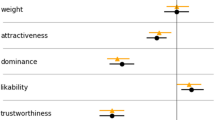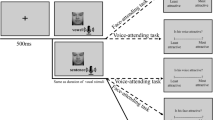Abstract
Dating conversations are especially influenced by the interlocutors’ perceived attractiveness. As visual attractiveness determines the course and nature of the interaction, the perceived overall quality of the conversation may also be influenced by the perceived attractiveness and simultaneously also affect the further development of the conversation. Accordingly, perceived attractiveness and conversational quality constantly interact in dating conversations. Studies focusing on the effects of both impressions on a speaker’s vocal behavior in terms of prosodic entrainment, i.e., the adaptation of a speaker’s prosodic features relative to his/her interlocutor, suggest that higher visual attractiveness leads to a greater divergence in f0 in mixed-sex pairs, while greater conversational quality results in larger degrees of f0 entrainment. In this paper, we further investigate the effects of both perceived attractiveness and conversational quality on prosodic entrainment of f0 in dating conversations with a special focus on their interaction. We conducted a dating experiment with 20 young heterosexual singles who engaged in 100 short spontaneous mixed-sex dating conversations. The results suggest that f0 entrainment correlates with both perceived attractiveness and conversational quality. Prosodic entrainment decreased with higher ratings of perceived attractiveness and increased with higher ratings of perceived conversational quality. Additionally, the results indicate that f0 entrainment not only depends on the impressions of attractiveness and conversational quality but also affects them. Furthermore, seemingly conflicting effects may be resolved by emphasizing one effect over the other, e.g., quality over attractiveness. This emphasis seems to depend on speaker sex and may also change during the course of the conversation. The details of this complex interaction, their interdependence, the importance of speaker sex, as well as possible implications are discussed.
Access this chapter
Tax calculation will be finalised at checkout
Purchases are for personal use only
Similar content being viewed by others
Notes
- 1.
However, this is only true if we restrict our investigation to dating conversations which aim at finding a potential partner, which of course is not true for every kind of dating conversation.
References
Bates, D., Maechler, M., Bolker, B., & Walker, S. (2015). Fitting linear mixed-effects models using lme4. Journal of Statistical Software, 67(1), 1–48.
Belz, M., Mooshammer, C., Fuchs, S., Jannedy, S., Rasskazova, O., & Żygis, M. (Eds.). (2018). Proceedings of the Conference on Phonetics & Phonology in German-Speaking Countries. Berlin: Humboldt Universität.
Beňuš, S. (2014). Social aspects of entrainment in spoken interaction. Cognitive Computation, 6(4), 802–813.
Beňuš, S., Trnka, M., Kuric, E., Matrák, L., Gravano, A., Hirschberg, J., & Levitan, R. (2018). Prosodic entrainment and trust in human-computer interaction. In Proceedings of Speech Prosody 9, Poznań, Poland (pp. 220–224).
Boersma, P., & Weenink, D. (2016). Praat: Doing phonetics by computer. Retrieved from http://www.fon.hum.uva.nl/praat/
Borkowska, B., & Pawlowski, B. (2011). Female voice frequency in the context of dominance and attractiveness perception. Animal Behaviour, 82(1), 55–59.
Brennen, S. E., & Clark, H. H. (1996). Conceptual pacts and lexical choice in conversation. Journal of Experimental Psychology: Learning, Memory and Cognition, 22(6), 1482–1493.
Brooks, A. B., Huang, L., Kearney, S. W., & Murray, F. E. (2014). Investors prefer entrepreneurial ventures pitched by attractive men. Proceedings of the National Academy of Sciences of the United States of America, 111, 4427–4431.
Chartrand, T. L., & Bargh, J. A. (1999). The chameleon effect: The perception-behavior link and social interaction. Journal of Personality and Social Psychology, 76(6), 893–910.
Cialdini, R. B. (2009). Influence: Science and Practice (5th ed.). Boston: Allyn & Bacon.
R Core Team. (2017). R: A language and environment for statistical computing. Vienna, Austria: R Foundation for Statistical Computing. Retrieved from https://www.R-project.org/.
Collins, S. A. (2000). Men’s voices and women’s choices. Animal Behaviour, 60, 773–780.
Collins, S. A., & Missing, C. (2003). Vocal and visual attractiveness are related in women. Animal Behaviour, 65, 997–1004.
Dunbar, R. I. M. Coevolution of neocortex size, group size and language in humans. Behavioural Brain Science, 16, 681–735.
Edlund, J., Heldner, M., & Hirschberg, J. (2009). Pause and gap length in face-to-face interaction. In Proceedings of INTERSPEECH 2009.
Feinberg, D. R., Debruine, L. M., Jones, B. C., & Perrett, D. I. (2005). Manipulations of fundamental and formant frequencies influence the attractiveness of human male voices. Animal Behaviour, 69, 561–568.
Feinberg, D. R., Debruine, L. M., Jones, B. C., & Perrett, D. I. (2008). The role of femininity and averageness of voice pitch in aesthetic judgements of women’s voices. Perception, 37, 615–623.
Fraccaro, P. J., Jones, B. C., Vukovic, J., Smith, F. G., Watkins, C. D., Feinberg, D. R., et al. (2011). Experimental evidence that women speak in higher voice pitch to men they find attractive. Journal of Evolutionary Psychology, 9(1), 57–67.
Friedberg, H., Litman, D., & Paletz, S. (2012). Lexical entrainment and success in student engineering groups. In Spoken Language Technology Workshop (SLT) 2012 (pp. 404–409). IEEE.
Gessinger, I., Schweitzer, A., Andreeva, B., Raveh, E., Möbius, B., & Steiner, I. (2018). Convergence of pitch accents in a shadowing task. In Proceedings of Speech Prosody, Poznań, Poland (vol. 9, pp. 225–229).
Giles, H., Coupland, N., & Coupland, J. (1991). Accomodation theory: Communication, context, and consequence. Contexts of Accomodation. Developments in Applied Sociolinguistics, 1.
Gonzales, A. L., Hancock, J. T., & Pennebaker, J. W. (2009). Language style matching as a predictor of social dynamics in small groups. Communication Research.
Gregory, S. W. (1996). A nonverbal signal in voices of interview partners effectively predicts communication accommodation and social status perceptions. Journal of Personality and Social Psychology, 70, 1231–1240.
Hewstone, M., Stroebe, W., & Jonas, K. (2012). An Introduction to Social Psychology (5th ed.). Hoboken, New Jersey: BPS Blackwell.
Hodges-Simeon, C. R., Gaulin, S. J. C., & Puts, D. A. (2010). Different vocal parameters predict perceptions of dominance and attractiveness. Human Nature, 21, 406–427.
Hughes, S. M., Farley, S. D., & Rhodes, B. C. (2010). Vocal and physiological changes in response to the physical attractiveness of conversational partners. Journal of Nonverbal Behavior, 34, 1–13.
Ireland, M. E., Slatcher, R. B., Eastwick, P. W., Scissors, L. E., Finkel, E. J., & Pennebaker, J. W. (2011). Language style matching predicts relationship initiation and stability. Psychological Science, 22, 39–44.
Jones, B. C., Feinberg, D. R., Debruine, L. M., Little, A. C., & Vukovic, J. (2010). A domain- specific opposite-sex bias in human preferences for manipulated voice pitch. Animal Behaviour, 79(57–62)
Karpf, A. (2006). The Human Voice. New York, NY: Bloomsbury Publishing.
Kuznetsova, A., Brockhoff, P. B., & Christensen, R. H. B. (2016). lmerTest: Tests in linear mixed effects models. R package version 2.0-30. Retrieved from https://CRAN.R-project.org/package=lmerTest
Ladd, R. D., Silverman, K., Tolkmitt, F., Bergmann, G., & Scherer, K. (1985). Evidence for the independent function of intonation contour type, voice quality, and f0 range in signaling speaker affect. Journal of the Acoustical Society of America, 78, 435–444.
Leaderbrand, K., Dekam, J., Morey, A., & Tuma, L. (2008). The effects of voice pitch on perceptions of attractiveness: Do you sound hot or not. Winona State University Psychology Student Journal.
Lee, C. C., Black, M. P., Katsamanis, A., Lammert, A. C., Baucom, B. R., Christensen, A., et al. (2010). Quantification of prosodic entrainment in affective spontaneous spoken interactions of married couples. Proceedings of Interspeech, 793–796.
Levitan, R. (2014). Acoustic-prosodic entrainment in human-human and human-computer dialogue. Columbia University. Ph.D. thesis.
Levitan, R., Gravano, A., Willson, L., Beňuš, S., Hirschberg, J., & Nenkova, A. (2012). Acoustic-prosodic entrainment and social behavior. In Proceedings of the 2012 Conference of the North American Chapter of the Association for Computational Linguistics: Human Language Technologies (pp. 11–19).
Linville, S. E. (1996). The sound of senescence. Journal of Voice, 10(2), 190–200.
Lubold, N., & Pon-Barry, H. (2014). Acoustic-Prosodic Entrainment and Rapport in Collaborative Learning Dialogues. Proceedings of the. (2014). ACM Workshop on Multimodal Learning Analytics Workshop and Grand Challenge, November 12–12, 2014, Turkey, Istanbul.
Michalsky, J. (2017). Pitch synchrony as an effect of perceived attractiveness and likability. In: Proceedings of DAGA 2017.
Michalsky, J., & Schoormann, H. (2016). Effects of perceived attractiveness and likability on global aspects of fundamental frequency. In Proceedings of P&P12 (120–124).
Michalsky, J., & Schoormann, H. (2017). Pitch convergence as an effect of perceived attractiveness and likability. In Proceedings of INTERSPEECH, 2017 (pp. 2253–2256).
Michalsky, J., Schoormann, H., & Niebuhr, O. (2018a). Conversational quality is affected by and reflected in prosodic entrainment. In: Proceedings of Speech Prosody, Poznań, Poland (vol. 9).
Michalsky, J., Schoormann, H., & Niebuhr, O. (2018b). Turn transitions as salient places for social signals—Local prosodic entrainment as a cue to perceived attractiveness and likability. In M. Belz, C. Mooshammer, S. Fuchs, S. Jannedy, O. Rasskazova, & M. Żgis (Eds.), Proceedings of the Conference on Phonetics & Phonology in German-Speaking Countries (pp. 169–172). Berlin: Humboldt Universität.
Natale, M. (1975). Convergence of mean vocal instenity in dyadic communication as a function of social desirability. Journal of Personality and Social Psychology, 32(5), 790–804.
Nenkova, A., Gravano, A., & Hirschberg, J. (2008). High frequency word entrainment in spoken dialogue. In Proceedings of the 46th Annual Meeting of the Association of Computational Linguistics on Human Language Technologies: Short Papers (pp. 169–172).
Oguchi, T., & Kikuchi, H. (1997). Voice and interpersonal attraction. Japanese Psychological Research, 39, 56–61.
Ohala, J. (1983). Cross-language use of pitch. An ethological view. Phonetica, 40, 1–18.
Ohala, J. (1984). An ethological perspective on common cross-language utilization of f0 in voice. Phonetica, 41, 1–16.
Pickering, M. J., & Garrod, S. (2006). Alignment as the basis for successful communication. Research on Language and Computation, 4, 203–228.
Puts, D. A., Gaulin, S. J. C., & Verdolini, J. (2006). Dominance and the evolution of sexual dimorphism in human voice pitch. Evolution and Human Behavior, 27, 283–296.
Reitter, D., & Moore, J. D. (2007). Predicting success in dialogue. Annual Meeting - Association for Computational Linguistics, 45, 808.
Scherer, K., Ladd, R. D., & Silverman, K. (1984). Vocal cues to speaker affect: testing two models. Journal of the Acoustical Society of America, 76, 1346–1356.
Schweitzer, A., Lewandowski, N., & Duran, D. (2017). Social attractiveness in dialogs. In Proceedings of INTERSPEECH 2017 (pp. 2243–2247).
Street, R. L. (1984). Speech convergence and speech evaluation in fact-finding interviews. Human Communication Research, 11(2), 139–169.
Taylor, J. G. (2009). Cognitive computation. Cognitive Computation, 1, 4–16.
Thomason, J., Nguyen, H. V., & Litman, D. (2013). Prosodic entrainment and tutoring dialogue success. Artificial Intelligence in Education, 750–753.
Vukovic, J., Jones, B. C., Debruine, L. M., Feinberg, D. R., Smith, F. G., Little, A. C., et al. (2010). Women’s own voice pitch predicts their preferences for masculinity in men’s voices. Behavioral Ecology, 21(4), 767–772.
Xu, Y., Lee, A., Wu, W.-L., Liu, X., & Birkholz, P. (2013). Human vocal attractiveness as signaled by body size projection. PLoS ONE, 8(4),
Zimmer-Gembeck, M. J., Hughes, N., Kelly, M., & Connoly, J. (2011). Intimacy, identity and status: Measuring dating goals in late adolescence and emerging adulthood. Motivation and Emotion, 36(3), 311–322.
Author information
Authors and Affiliations
Corresponding author
Editor information
Editors and Affiliations
Rights and permissions
Copyright information
© 2021 Springer Nature Singapore Pte Ltd.
About this chapter
Cite this chapter
Michalsky, J., Schoormann, H. (2021). Birds of a Feather Flock Together But Opposites Attract! On the Interaction of F0 Entrainment, Perceived Attractiveness, and Conversational Quality in Dating Conversations. In: Weiss, B., Trouvain, J., Barkat-Defradas, M., Ohala, J.J. (eds) Voice Attractiveness. Prosody, Phonology and Phonetics. Springer, Singapore. https://doi.org/10.1007/978-981-15-6627-1_12
Download citation
DOI: https://doi.org/10.1007/978-981-15-6627-1_12
Published:
Publisher Name: Springer, Singapore
Print ISBN: 978-981-15-6626-4
Online ISBN: 978-981-15-6627-1
eBook Packages: Social SciencesSocial Sciences (R0)




